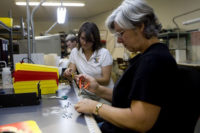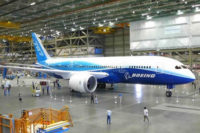In addition to using the latest lean manufacturing principles, Boeing's new 787 assembly plant is one of the greenest factories in the aerospace industry.
Boeing Commercial Airplanes recently opened its first new assembly plant in the United States in 40 years. The $750 million facility in North Charleston, SC, will build the 787 Dreamliner. It will help Boeing boost capacity of its long overdue jetliner from three aircraft per month today to 10 aircraft per month by 2013.
The South Carolina plant is currently building its first aircraft. The 787 will be the first Boeing jetliner assembled outside the company’s traditional manufacturing base in the Seattle region.
In addition to using the latest lean manufacturing principles, the facility will be one of the greenest in the aerospace industry. For instance, Boeing South Carolina is the first major commercial airplane production site within Boeing to achieve zero waste to landfill status. Through an aggressive and expansive site-wide recycling and reuse initiative, none of the factory’s nonhazardous waste is sent to landfills.
“The 787 we’ll build here in South Carolina is designed to be manufactured using fewer hazardous materials, consume less fuel and produce fewer emissions,” says Candy Eslinger, communications manager for Boeing South Carolina. “And, at the end of the airplane’s service life, the materials used for the 787 are recyclable. It only makes sense that our business operations reflect the environmental progressiveness of our product.”
A thin-film solar laminate energy generation system installed on the roof of the final assembly building will be among the 10 largest such installations in the U.S. by production capacity, providing 15 percent to 20 percent of the entire site’s energy needs.
“The remainder of the site’s energy will derive from renewable resources, making Boeing South Carolina the first Boeing site to commit to 100 percent renewable energy use,” claims Eslinger. “We are targeting LEED Silver certification for the final assembly building, and all new construction onsite, as determined by the U.S. Green Building Council.”
Get our new eMagazine delivered to your inbox every month.
Stay in the know on the latest assembly trends.
SUBSCRIBE TODAY!Copyright ©2024. All Rights Reserved BNP Media.
Design, CMS, Hosting & Web Development :: ePublishing


